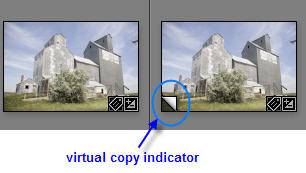I wrote a post recently about making snapshots while you work so that you can explore different versions of your image — for example, a black and white and a color version — with the goal of having just one version in the end.
If you want to end up with two or more versions — to export to share with others, or to use in the output modules, you can do so with virtual copies. Simply right click on your image and select “Create Virtual Copy”. You’ll see in Library Grid view or in your filmstrip that you now have two copies, and that the second one has a bent page corner symbol, indicating that it is a virtual copy.

You can now work on this second one as a completely independent image, converting it to black and white, cropping it differently than the first one, etc, etc.
Why is it called a virtual copy? Because no duplicate of your original file is created. A virtual copy is simply a second set of instructions to be applied to the one original file. The days of having many different copies of your images on your hard drive for different purposes are over!
If you use virtual copies, leave a comment here sharing what you use them for.
